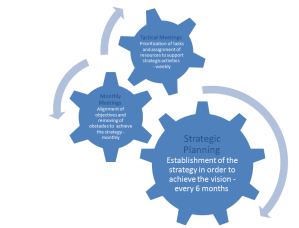Our organization is using an innovative human resource management approach inspired by the “golfer – caddy” relationship in golf. Although the approach isn’t fully matured and there are still adjustments to be made, I believe there is value in sharing the process.
Some background
During its early years, human resources management was done entirely by the management team. The communication was centralized and the company’s founders had relations with all employees. They were responsible for hiring, annual evaluations and taking decisions relating to salary revisions. The fast growth of the organization highlighted certain limitations:
- Managing the relationships between employees and the founders was increasingly difficult to maintain as the organization grew;
- The centralized communication channels weren’t efficient;
- The willingness to develop a new process without hiring specialized HR specialists;
- The management of special situations and salary determination lacked transparency and were perceived to be unfair.
To address these emerging issues, the organization developed the “Caddy” process, a model of decentralized community-based human resource management.
What is a Caddy?
In golf, the caddy is the person who carries the golf bag, gives advice and provides moral support. A good caddy is aware of the difficulties, obstacles and peculiarities of the course, as well as the best strategies to play the course. The caddy is not the one who plays the game, the golfer is!
Objectives of the process
The objective of the process is to support employees’ success and monitor their well-being. In addition, the caddy process is a way for all employees to participate in the management of the organization by helping their peers to receive the proper feedback and skills to be successful in their role. The caddy process is deemed more efficient than the traditional hierarchical model.
The process
When an employee joins the company, he/she is assigned a caddy for a period of six months. After that period, an employee may decide to change caddy any time. A discussion between the golfer and the new caddy is required to identify the expectations of each party and determine if the match is possible and desirable.
Role and responsibilities of the Caddy
The caddy has certain responsibilities to the employee. In a traditional organization, these responsibilities are held by the Human Resources Department:
- Communication of the corporate strategy;
- Keeping track of business objectives;
- Accompanying the employee in his career development and providing the support to develop new skills;
- Assisting the employee to set goals and support them in achieving these objectives by offering the means to do so;
- Preparing the salary revisions and making recommendations.
Caddy Team Charter
“I am unwavering in the success of each of my players, my caddy and the caddy team”.
Why?
Because people are the most important asset of the organization. Their development is linked to the success of the organization.
What?
The Caddy process is based on trust and respect. It is a relationship of support and coaching without direct authority.
Who?
The Caddy is a humble person with great listening capabilities. He has the courage to confront the person if necessary and the wisdom to do so in respect of the person. Above all, he shares a common goal with his golfers: the professional success and development of the latter.
Mean
The Caddying is one of the most important roles in the organization and he is recognized as such, encouraged and valued by the organization.
Result
The Caddy process has a significant positive impact on the development of the golfer.

Recent Comments